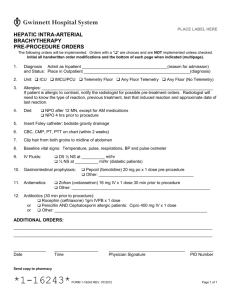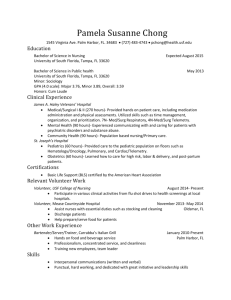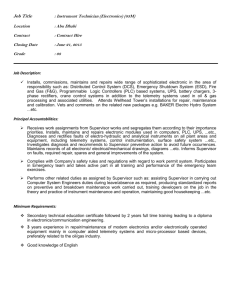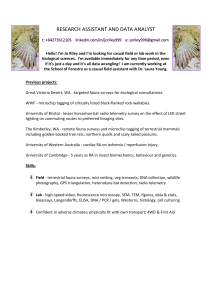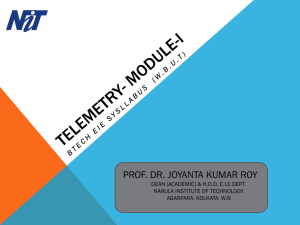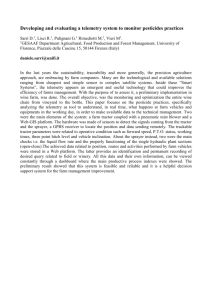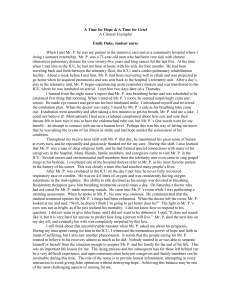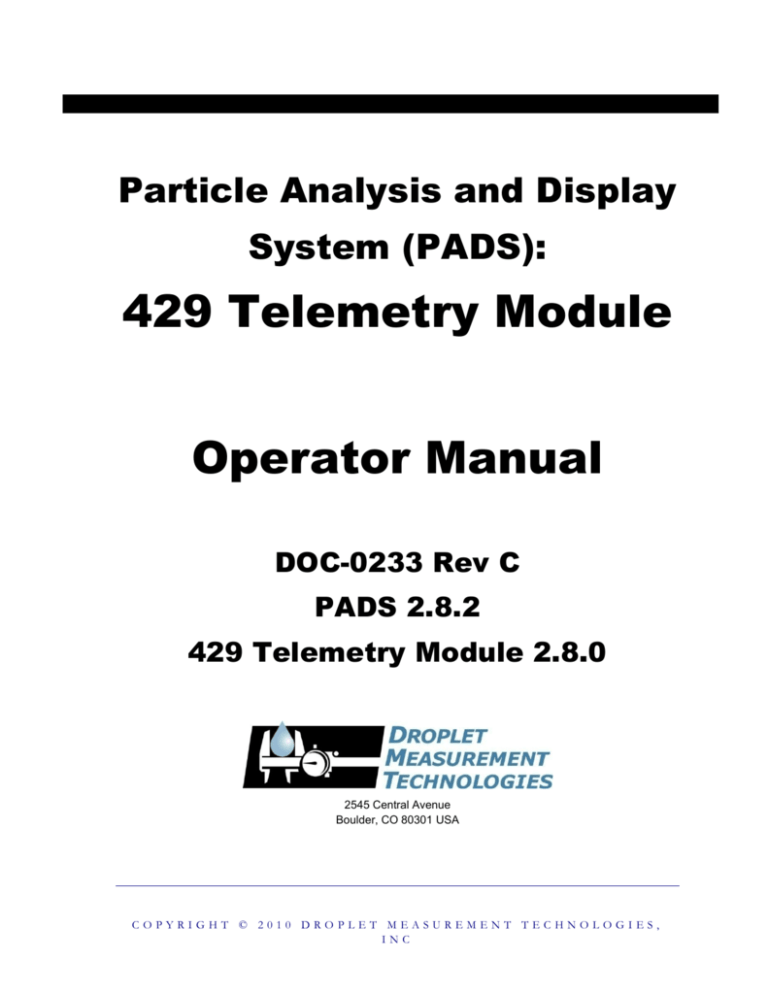
Particle Analysis and Display
System (PADS):
429 Telemetry Module
Operator Manual
DOC-0233 Rev C
PADS 2.8.2
429 Telemetry Module 2.8.0
2545 Central Avenue
Boulder, CO 80301 USA
COPYRIGHT © 2010 DROPLET MEASUREMENT TECHNOLOGIES,
INC
PADS Manual – 429_Telemetry Module
Copyright © 2010 Droplet Measurement Technologies, Inc.
2545 CENTRAL AVENUE
BOULDER, COLORADO, USA 80301-5727
TEL: +1 (303) 440-5576
FAX: +1 (303) 440-1965
WWW.DROPLETMEASUREMENT.COM
All rights reserved. DMT licenses PADS software only upon the condition that you accept all of the
terms contained in this license agreement. Each PADS license you purchase allows you to acquire
data on one computer only. Data can be viewed in playback mode on an unlimited number of
computers.
This software is provided by DMT “as is” and any express or implied warranties, including, but not
limited to, the implied warranties of merchantability and fitness for a particular purpose are
disclaimed. Under no circumstances and under no legal theory, whether in tort, contract, or
otherwise, shall DMT or its developers be liable for any direct, indirect, incidental, special,
exemplary, or consequential damages (including damages for work stoppage; computer failure or
malfunction; loss of goodwill; loss of use, data or profits; or for any and all other damages and
losses).
Some states do not allow the limitation or exclusion of implied warranties and you may be entitled to
additional rights in those states.
Trademark Information
All Droplet Measurement Technologies, Inc. product names and the Droplet Measurement
Technologies, Inc. logo are trademarks of Droplet Measurement Technologies, Inc.
All other brands and product names are trademarks or registered trademarks of their respective
owners.
Risks of Installing Additional Software
Instrument computers from DMT are configured to acquire data in a reliable, robust manner.
Typically, such instruments are either not connected to a network or are connected to a small, local
network that is isolated from the internet, reducing the risk of viruses. Since anti-virus programs can
cause erratic behavior when run in the background on data acquisition computers, DMT does not
install anti-virus, anti-spam, or anti-malware programs. If you choose to install these programs, you
accept the risk associated with them in terms of potential performance degradation of the software
installed by DMT.
DOC-0233 Rev C
© 2010 DROPLET MEASUREMENT TECHNOLOGIES, INC.
II
PADS Manual – 429_Telemetry Module
For similar reasons, DMT recommends that you do not install or run other software on the dedicated
instrument computer. Although the installation of some software may be unavoidable, it is
particularly important not to run other software while the computer is acquiring data.
DOC-0233 Rev C
© 2010 DROPLET MEASUREMENT TECHNOLOGIES, INC.
III
PADS Manual – 429_Telemetry Module
CONTENTS
1.0 Introduction ............................................................................. 5
2.0 Configuring the Display ............................................................... 5
Selectable Charts and Tabular Data Displays ................................................... 7
429 Telemetry Channels ........................................................................... 7
3.0 The 429 Telemetry Window ........................................................ 10
Numeric Data ....................................................................................... 10
Chart Displays ...................................................................................... 11
429 Telemetry Channels .......................................................................... 13
Appendix A: ARINC 429 Data Bus Characteristics .................................... 14
Electrical Characteristics ......................................................................... 14
Data Protocol ....................................................................................... 14
Data Fields .......................................................................................... 15
Parity ............................................................................................. 15
Sign/Status Matrix (SSM)....................................................................... 15
Data ............................................................................................... 16
Source Destination Indicator .................................................................. 16
Label .............................................................................................. 16
How DMT Uses the ARINC 429 .................................................................... 17
Appendix B: ARINC 429 Transmission Issues .......................................... 19
Timing Issues ....................................................................................... 19
Processor Overload Issues ........................................................................ 20
Appendix C: Revisions to Manual ....................................................... 22
List of Figures
Figure 1:
Figure 2:
Figure 3:
Figure 4:
429 Telemetry Display Editor Window ..................................... 6
Selecting 429 Telemetry Channels .......................................... 8
429 Telemetry Channels Scrollbar and Cursor ............................ 8
429 Telemetry Main Window ................................................ 11
DOC-0233 Rev C
© 2010 DROPLET MEASUREMENT TECHNOLOGIES, INC.
IV
PADS Manual – 429_Telemetry Module
1.0 Introduction
The Particle Analysis and Display System (PADS) is a software package that interfaces
with all the instruments produced by Droplet Measurement Technologies (DMT) and other
leading instruments used in the atmospheric sciences. This manual describes the PADS
module for the 429 Telemetry display. The 429 Telemetry display allows you to view and
analyze data from several instruments simultaneously. It also allows you to feed selected
data to an ARINC 429 port for use with an external data system.
For an explanation of the basic PADS setup and instructions on how to acquire data using
PADS, consult the PADS Operator Manual, DOC-0116. This manual also gives definitions
for all the channels that the 429 Telemetry tab can display.
2.0 Configuring the Display
Because the 429 Telemetry tab displays data from several different instruments, you
cannot use the 429 Telemetry screen to configure instruments. Therefore, the Configure
Instrument option on the Configure menu has been grayed out. If you want to configure
an instrument that has data displayed in the 429 Telemetry tab, click on that
instrument’s tab in PADS and select Configure Instrument.
To configure the 429 Telemetry display and the ARINC 429 data transmission settings,
follow the steps below.
1. Click on the ―429 Telemetry‖ tab.
2. From the Configure menu, select Configure Display. You will see the following
window.
DOC-0233 Rev C
© 2010 DROPLET MEASUREMENT TECHNOLOGIES, INC.
5
PADS Manual – 429_Telemetry Module
Figure 1: 429 Telemetry Display Editor Window
You do not need to modify the Display #.
Changing the Refresh Time allows you to set the time intervals for data display during
acquisition mode. You can choose any time that is equal to or greater than the
instruments’ sample times. (Choosing a time less than the sample time is not useful,
since the same data will be displayed and sent over the 429 Telemetry port multiple
times.) If the instruments displayed on the 429 Telemetry tab have different sampling
times, setting the refresh time to that of the fastest sample time will give the best
results. In addition, the Refresh Time also specifies the time interval at which the 429
Telemetry data is sent over the ARINC 419 port.
The Card Number specifies the number of the plug-in card in the computer hardware.
The Speed field indicates whether ARINC 429 data is transmitted at high speed (100
Kb/sec) or low speed (12.5 Kb/sec).
The Telemetry On/Off button allows users to specify whether data should be sent over
the ARINC 429 telemetry port. When this button is off, no data are sent. When it is on,
the computer will relay the channels specified in the 429_telemetry channels in the far
right table. The Telemetry On/Off setting selected on the Display Editor will be the
default setting when PADS opens. However, you can change the setting for the current
sampling instance only by using the same button on the main 429 Telemetry window.
DOC-0233 Rev C
© 2010 DROPLET MEASUREMENT TECHNOLOGIES, INC.
6
PADS Manual – 429_Telemetry Module
Selectable Charts and Tabular Data Displays
The Display Editor allows you to define sets of data that the 429 Telemetry window
displays. A set is basically a single configuration of the 429 Telemetry window. It
specifies items 1-7 that PADS uses in this display. (Figure 4 illustrates where these items
appear on the 429 Telemetry display.) Note that any set can include channels from any
instrument in the system. For instance, you might define a set called ―LWC‖ that displays
and graphs LWC readings from various instruments. For information on channels and their
definitions, see Appendix A of the PADS Operator Manual, DOC-0116.
The button to the left of item 5 allows you to specify how a given set should graph items
4 and 5—with respect to each other, or with respect to time.
The box in the bottom left of the Display Editor lists all the available data sets. You can
add sets and delete sets using the buttons above the box. When you add a set, you
specify the set name and all the item numbers using the controls in the box at the
bottom center of the display editor.
Note that all of these chart and channel parameters are also changeable from the 429
Telemetry main window, as discussed in section 3.0. Changing the parameters directly on
the 429 Telemetry display changes them for the current session only, while changing
them here on the Display Editor window creates parameter sets that are also available in
future sessions.
429 Telemetry Channels
The 429 Telemetry Channels table to the right of the screen allows you to specify
channel data to be sent over the ARINC 429 port. Clicking on a row in the 429 Telemetry
Channels table brings up a list of all available channels, as shown in the figure below.
DOC-0233 Rev C
© 2010 DROPLET MEASUREMENT TECHNOLOGIES, INC.
7
PADS Manual – 429_Telemetry Module
Figure 2: Selecting 429 Telemetry Channels
Using 429 telemetry channels allows you to capture these data using an external system.
You can add and delete 429 telemetry channels using the buttons beneath the channels
list. The scrollbar to the right of the 429_Telemetry Channels column allows you to move
quickly through the list of available channels. The cursor to the right of the scrollbar
allows you to specify where channels should be inserted or deleted. For instance, if the
cursor is set as in Figure 3, pressing the Delete button would delete the telemetry
channel CCP Summary3_TotalED.
Figure 3: 429 Telemetry Channels Scrollbar and Cursor
DOC-0233 Rev C
© 2010 DROPLET MEASUREMENT TECHNOLOGIES, INC.
8
PADS Manual – 429_Telemetry Module
PADS stores the telemetry channel names in C:\Program Files\PADS\Telemetry
Output Channels.txt. This file is updated every time you change and save the
Telemetry Display configuration. The file is a simple ASCII text file, and it is an output
file only. The programmer of the data system that will be receiving the 429 Telemetry
data can use this file to determine the formatting of the channels being sent. There is no
mechanism for importing this channel list into PADS, so there is no need to edit this file.
It is for reference only.
Pressing the Reset to Defaults button will set the telemetry channels and their
corresponding labels and ranges to the default values. These values are designed for a
Combination Cloud Probe (CCP) configuration, with the first four PADS tabs assigned to
the Cloud Imaging Probe (CIP), Cloud Droplet Probe (CDP), Hotwire Liquid Water Content
Sensor (LWC), and CCP Summary tab, respectively. If the Reset to Defaults button is
pressed when PADS has a different configuration than stated here, the resulting channels
will have little relevance to what should actually be configured.
The 429 Label column indicates the label used to identify a channel in the ARINC 429
data stream. Each label must be unique, although labels do not need to be listed in a
consecutive order on the Display Editor screen. Note that the default telemetry channels’
labels do not necessarily conform to industry standards—for instance, label 204 identifies
the default channel CCP Summary3_CIP Bin 5 in PADS, while industry standard assigns
label 204 to barometric altitude. Likewise, users are free to assign labels to PADS
channels as they choose, so long as the same label is not assigned to multiple channels.
The Range (low/high) fields specify how PADS encodes the real numbers recorded in data
channels into the positive-integer format that the ARINC 429 device requires. Likewise,
after transmission the range information is useful in decoding 429 telemetry data in an
external data system.
The PADS encoding uses the following conventions:
-
For ranges with a low of 0 and a high of 65, an ARINC 429 value of ―ABCDE‖
denotes a real number AB.CDE, where AB <= 65.
For ranges with a low of 0 and a high of 655, an ARINC 429 value of ―ABCDE‖
denotes a real number ABC.DE, where ABC <= 655.
For ranges with a low of 0 and a high of 6553, an ARINC 429 value of ―ABCDE‖
denotes a real number ABCD.E, where ABCD <= 6553.
For ranges with a low of 0 and a high of 65553, an ARINC 429 value of ―ABCDE‖
denotes a real number ABCDE, where ABCDE <= 65535.
If a channel’s value must include negative numbers, the high range should be ½
that shown above, and the low range should be the negative of the high range.
Thus a channel that could have values from -60 to +120, such as a temperature,
DOC-0233 Rev C
© 2010 DROPLET MEASUREMENT TECHNOLOGIES, INC.
9
PADS Manual – 429_Telemetry Module
should use the values -327 and 327 for the high and low ranges, so that values
such as –ABC.DE to +ABC.DE can be transmitted.
Note: PADS uses the above conventions even though the ARINC 429 port actually uses 18
bits (for range of 0 – 262143) rather than 16 bits (for a range of 0 – 65535).
When you are done changing parameters on the Display Editor window, click on Save to
update the configurations or Cancel to revert to the previous configurations. After you
reset PADS, you will be able to see any changes by viewing the 429 Telemetry display.
Note that clicking Reset Program will clear out any data currently being displayed.
3.0 The 429 Telemetry Window
The 429 telemetry window displays channel data in numeric and graphical form. It also
provides information on the currently selected telemetry channels and whether
telemetry is on or off.
Numeric Data
The top of the Telemetry window displays three time-specific channels in numeric form.
These channels correspond to Items 1 – 3 on the Display Editor window (see Figure 1).
PADS displays the data values just to the right of the field listing the data channel names.
DOC-0233 Rev C
© 2010 DROPLET MEASUREMENT TECHNOLOGIES, INC.
10
PADS Manual – 429_Telemetry Module
Figure 4: 429 Telemetry Main Window
Chart Displays
The telemetry window contains two graphs. Items 4 and 5 determine the channels PADS
charts in the top graph. By default, PADS charts both of these channels with respect to
time. Item 4 is displayed in blue and has its legend on the left side of the graph. Item 5 is
charted in red and has a legend on the graph’s right side.
You can change default time-series setting upon start-up by pressing the 2 Chan vs. Time
button on the Display Editor screen. This changes the button so it reads Chan vs. Chan,
and the Telemetry’s top graph displays the two channels charted with respect to each
other. The Chan vs. Chan option charts Channel 4 on the x axis and Channel 5 on the y
axis.
Items 6 and 7 determine the channels PADS charts in the bottom graph. Item 6 is
displayed in blue and has its legend on the left side of the graph. Item 7 is charted in red
and has a legend on the graph’s right side.
DOC-0233 Rev C
© 2010 DROPLET MEASUREMENT TECHNOLOGIES, INC.
11
PADS Manual – 429_Telemetry Module
If you have created sets on the Display Editor screen (see section 2.0), you can display
these pre-specified channels by selecting the desired set in the Display Set control in the
upper left of the screen. You can also change the channels being displayed by directly
editing the item fields shown in Figure 4. If you modify the item fields this way, the
Display Set value changes to ―User Defined.‖ You can revert to a pre-defined set by
selecting that set in Display Set.
For information on specific channels, their definitions, and their acceptable ranges,
consult PADS Operator Manual’s Appendix A: Definitions.
When you access time-series charts in playback mode, the currently selected moment in
time is indicated by a red cursor. The y-axis value for this time is indicated by cross (+)
on this cursor. This y-axis value is always for the channel listed on the left side of the
graph, i.e. the one that PADS displays in blue.
Note that when you display a large range of time-series data, the chart display does not
have sufficient resolution to display each individual time point. To increase resolution,
zoom in on the data by changing the time interval to a smaller range.
On both the top and bottom charts, you can change the scale by typing a different
number into the starting and ending values on each axis.
The charts also show you options for scaling and copying the data when you right-click on
the graph. These options are as follows:
Autoscale X / Autoscale Y Right-clicking on an axis brings up an autoscaling
option for that axis, which allows you to enable or disable autoscaling. Note that
on the Telemetry charts, it is possible to enable autoscaling on one y-axis and
disable it on the other. If you disable autoscaling, the scale of the axis will remain
constant. In this case, the range will always be the same as it was when
autoscaling was disabled. The minimum and maximum Y values can then be
changed manually by typing new numbers into these fields. In playback mode,
autoscaling will not take effect until you change the time using the time controls.
Copy Data
capture.
This copies the histogram chart to the clipboard using a screen
Export Simplified Image This copies a simplified image of the data to the
clipboard or an output file. You can choose the format you desire—bitmap (.bmp),
encapsulated postscript (.eps), or enhanced metafile (.emf). Note that when you
select the .eps option, you must copy the data to a file. Unless you specify
DOC-0233 Rev C
© 2010 DROPLET MEASUREMENT TECHNOLOGIES, INC.
12
PADS Manual – 429_Telemetry Module
otherwise, output files will be saved in the time-and-date-specific output file
directory for the current session.
Clear Graph This lets you clear the graph of the currently displayed data points.
429 Telemetry Channels
429 Telemetry channel data appear to the right of the chart displays. During acquisition
mode, the Telemetry On/Off button at the top of the screen allows you to start or stop
the telemetry data feeding to the ARINC 429 port. (Clicking this button during playback
mode has no effect.) When the button is on and the system instruments are sampling, any
channels listed in the 429_Telemetry Channels fields are fed in a serial data stream to
the ARINC 429 port. You can then capture this data using an external system. PADS also
displays the current values for these channels in the Data field on the far right of the
Telemetry screen.
To add and delete telemetry channels, go to Configure > Configure Display and modify
the telemetry channels listed on the right of the Display Editor screen.
Note that while the PADS 429 telemetry module does not generate its own output file,
any channels listed as telemetry channels will have their data stored in the relevant
instrument output file.
DOC-0233 Rev C
© 2010 DROPLET MEASUREMENT TECHNOLOGIES, INC.
13
PADS Manual – 429_Telemetry Module
Appendix A: ARINC 429 Data Bus Characteristics
ARINC 429 is the most common data bus for commercial aircraft. It has the following
characteristics:
Data are transmitted uni-directionally in 32-bit words over bipolar RZ format.
Common data types are BCD and BNR, which are described below.
Electrical Characteristics
Nominal transmission voltage is 10 + 1 volts differential, using bipolar return-to-zero
modulation.
HI is nominally between 7.25 to 11 volts.
LO is -7.25 to -11 volts.
NULL is 0.5 to -0.5 volts.
Slew rate:
- High speed: 1.5 + 0.5 µsec
- Low speed: 10 + 5 µsec
Data Protocol
Point to point
12.5 or 100 Kb/sec
Tx and Rx on separate lines
One Tx, 1 – 20 Rx
One Tx per line
32-bit words
4 NULL (zero voltage) bits between words
Typically one word per packet, although up to 512 are possible
Label field defines data type
DOC-0233 Rev C
© 2010 DROPLET MEASUREMENT TECHNOLOGIES, INC.
14
PADS Manual – 429_Telemetry Module
Data Fields
There are five primary fields:
Parity bit (1 bit)
Sign/Status Matrix (SSM) (2 bits – determines if number is signed or unsigned)
Sign (S) (1 bit – determines whether number is positive or negative, if signed)
Data (18 bits)
Source Destination Indicator (SDI) (2 bits)
Label (8 bits)
These fields are described in more detail below.
MSB
LSB
32 31 30 29 28 27 26 25 24 23 22 21 20 19 18 17 16 15 14 13 12 11 10 9
8
P SSM S DATA (MSB) →
LABEL
(LSB)
← DISCRETES
← PAD
SDI
7
6
5
4
(LSB)
3
→
Parity
ARINC 429 uses an odd parity bit, meaning the parity bit will toggle to create an odd
number of ones in the word.
Sign/Status Matrix (SSM)
This field contains the hardware status, operation mode, or data validity. The field varies
based on the data type, which is determined by the device. (The Label field indicates
which device is being used.)
For BCD data type:
00 Plus, North, East, Right, To, or Above
01 No Computed Data
10 Functional Test
11 Minus, South, West, Left, From, Below
DOC-0233 Rev C
© 2010 DROPLET MEASUREMENT TECHNOLOGIES, INC.
15
2
1
(MSB)
PADS Manual – 429_Telemetry Module
For BNR data type:
00 Failure Warning (can occur even during
normal operation), or unsigned
01 No Computed Data
10 Functional Test
11 Normal Operation, or signed
Data
The 18 bits may overrun the Source Destination Indicator (SDI) for extra precision.
Common data types are BCD, BNR, Discrete, Maintenance, Acknowledgment, and
Character data.
The two most common data types are:
Two’s-Complement (BNR) is the most common format, and the one used by DMT. This
encoding stores the data in binary form. Bit 29 is the sign bit (positive or negative), and
bit 28 is the MSB. The MSB represents half the maximum data value, with each successive
bit representing half the preceding bit’s value. Negative values are found by inverting all
bits and adding one to the least significant bit.
Binary Coded Decimal (BCD), which encodes decimal values in four-bit blocks. Due to
size limitations, when transmitting five digits, the most significant digit is limited to
decimal value seven; however, transmitting four digits removes this limitation.
Source Destination Indicator
In a system with multiple receivers, this field identifies the destination of packets. In a
complex system, it can be used to identify the transmitter. Occasionally it is used for
data.
Label
The label identifies the data type and accompanying parameters. It is typically
represented in octal form.
DOC-0233 Rev C
© 2010 DROPLET MEASUREMENT TECHNOLOGIES, INC.
16
PADS Manual – 429_Telemetry Module
How DMT Uses the ARINC 429
The entire data packet (Data, Label, SDI, etc.) is transmitted from LSB to MSB, meaning
the Label field is received first and the parity bit last.
PADS can be used to set the ARINC 429 transmission rate; see the description of the
Speed button in section 2.0. The Label fields in PADS allow users to assign specific data
from attached probes. This is described in the ―429 Telemetry Channels‖ section.
As stated above, DMT uses BNR/two’s-complement for the Data field. The data are stored
in 18 bits (not including the sign bit) with zero padding. Two's complement values use
sign extension such that positive values are preceded by 0’s and negative values with 1’s.
Bit 11 is the LSB of the data portion and is typically a fractional value. Bit 29 stores the
sign. It is unused for unsigned values, and remains a zero. For signed values, it is a one.
Fractions are represented as 1/2x, where x is a position relative to the decimal point.
Examples Converting Negative Numbers to Two’s Complement
One can calculate a two’s complement version of a binary number by inverting all the
bits and adding a single bit to the LSB of the entire data block.
-110
=
-00012
11102 +12
=
11112
-1.510
=
-01.102
10.012 +.012
=
10.102
-3.7510
=
-11.112
00.002 +.012
=
(1)00.012
-16.2510
=
-00010000.01002 11101111.10112 +.00012 = 11101111.11002
Examples of How Numbers are Padded for Different Scales
When sending the value 1.5 across Arinc429 we receive the following values according to
scaling:
Scaling:
Binary Value:
0 to 6
0 to 65
0 to 655
0 to 6553
0 to 65535
-32 to 32
-327 to 327
0001100000000000000
0000000110000000000
0000000000110000000
0000000000000110000
0000000000000000110
0000011000000000000
0000000001100000000
DOC-0233 Rev C
© 2010 DROPLET MEASUREMENT TECHNOLOGIES, INC.
The LSB for Integer Data is bit 26
The LSB for Integer Data is bit 22
The LSB for Integer Data is bit 19
The LSB for Integer Data is bit 16
The LSB for Integer Data is bit 13
The LSB for Integer Data is bit 24
The LSB for Integer Data is bit 20
17
PADS Manual – 429_Telemetry Module
When sending 1.25:
Scaling:
Binary Value:
0 to 6
0 to 65
0 to 655
0 to 6553
0 to 65535
-32 to 32
-327 to 327
0001010000000000000
0000000101000000000
0000000000101000000
0000000000000101000
0000000000000000101
0000010100000000000
0000000001010000000
The LSB for Integer Data is bit 26
The LSB for Integer Data is bit 22
The LSB for Integer Data is bit 19
The LSB for Integer Data is bit 16
The LSB for Integer Data is bit 13
The LSB for Integer Data is bit 24
The LSB for Integer Data is bit 20
When sending 1.29:
Scaling:
Binary Value:
0 to 6
0 to 65
0 to 655
0 to 6553
0 to 65535
-32 to 32
-327 to 327
0001010010100011110
0000000101001010001
0000000000101001010
0000000000000101000
0000000000000000101
0000010100101000111
0000000001010010100
The LSB for Integer Data is bit 26
The LSB for Integer Data is bit 22
The LSB for Integer Data is bit 19
The LSB for Integer Data is bit 16
The LSB for Integer Data is bit 13
The LSB for Integer Data is bit 24
The LSB for Integer Data is bit 20
The first bit in any of these values is zero, because the values are all unsigned numbers.
This bit does not carry data.
When sending -1.5:
Scaling:
Binary Value:
-32 to 32
-327 to 327
1111101000000000000
1111111110100000000
The LSB for Integer Data is bit 24
The LSB for Integer Data is bit 20
These are in two’s complement.
DOC-0233 Rev C
© 2010 DROPLET MEASUREMENT TECHNOLOGIES, INC.
18
PADS Manual – 429_Telemetry Module
Appendix B: ARINC 429 Transmission Issues
Timing Issues
There are four separate data transmissions that occur when an ARINC 429 adapter is used
with PADS and a DMT probe. Data are first transmitted from the probe to the PADS
computer instrument module, then from the PADS instrument module to the PADS 429
module, then from PADS 429 module to the ARINC 429 telemetry device, and finally from
the ARINC 429 device to the ultimate destination.
The last of these transmissions occurs at a precise interval, since the ARINC 429 adapter
transmits data every second, independently of the data received. The timing of the
second and third transmissions are more variable. Due to the timing issues internal to any
user space program, there are small changes to the clock cycle in PADS. This means that
the sample time set by the user may be off by up to 2%.
While seemingly small, this inconsistency in timing means there are issues when sending
synchronous data to the external source. This is illustrated by the figure below, where
PADS cycles are depicted with the solid lines. If the ARINC device transmits data exactly
every second (i.e., on the dotted lines) then some of the PADS-generated data will be
missed, while some samples will be sent twice.
To avoid this problem and ensure that the adapter is sending the most current data, PADS
updates the telemetry data at 95% of the normal clock cycle. This ensures that for the
vast majority of transmissions, the ARINC device has the most up-to-date information.
However, this scheme introduces a constant drift between the PADS transmission and the
ARINC transmission. This drift in turn results in two new complications. These are shown
in the following figure, which illustrates the effect with a PADS telemetry transmission
rate of 60% (rather than the actual 95%) to highlight the problem.
DOC-0233 Rev C
© 2010 DROPLET MEASUREMENT TECHNOLOGIES, INC.
19
PADS Manual – 429_Telemetry Module
In the cases marked with an ―A,‖ two PADS telemetry transmissions occur within a single
cycle of the general PADS cycle. This results in duplicate data being sent to the ARINC.
A second potential problem results in data being lost. In the cases marked with a ―B,‖
two PADS telemetry transmissions occur within a single ARINC transmission cycle. This
means that the first set of data are never transmitted from the ARINC. In some instances,
e.g. with the two PADS samples that are transmitted between 1.5 and 2.5 seconds, the
first PADS sample is actually a duplicate of the previous sample, which was already sent
at 1.5 seconds. In this instance, it does not matter that this transmission is lost. In other
cases, however, the ARINC has not yet sent the first PADS data packet, and these data
are completely omitted from the final serial stream.
Processor Overload Issues
The second issue regarding the ARINC to USB conversion is lost packets due to processor
overload. When running PADS in conjunction with the ARINC adapter, it is possible to
overload the CPU, particularly when an imaging probe is acquiring a high concentration of
particle images. This results in lost packets due to lost cycles. To reduce the possibility of
lost packets, the number of channels transmitted must be limited.
For an ADL PC 104 stack (as is typically used in a DMT APDS (Airborne Power Distribution
System)), operating a probe without any particles, it is possible to transmit 150 channels
per second from the 429_telemetry tab. However, at normal operating levels, the probe
can only handle 128 channels. When running the spinning disk image test device at full
DOC-0233 Rev C
© 2010 DROPLET MEASUREMENT TECHNOLOGIES, INC.
20
PADS Manual – 429_Telemetry Module
speed, a maximum of 110 channels is recommended. (With a more powerful processor,
additional channels may be possible.) These limits will minimize dropped packets from
overload.
DOC-0233 Rev C
© 2010 DROPLET MEASUREMENT TECHNOLOGIES, INC.
21
PADS Manual – 429_Telemetry Module
Appendix C: Revisions to Manual
Rev. Date
Rev. No.
Summary
Section
1-18-10
A-2
Added information on ARINC 429 data protocol
Appendix A
2-9-10
A-3
Added information on ARINC 429 transmission issues
Appendix B
4-10-10
B
Updated information on ARINC 429 data protocol
Appendix A
8-30-10
C
Corrected mistakes in binary-data examples for
0 to 6553 and -32 to 32 scalings
Appendix A
DOC-0233 Rev C
© 2010 DROPLET MEASUREMENT TECHNOLOGIES, INC.
22

